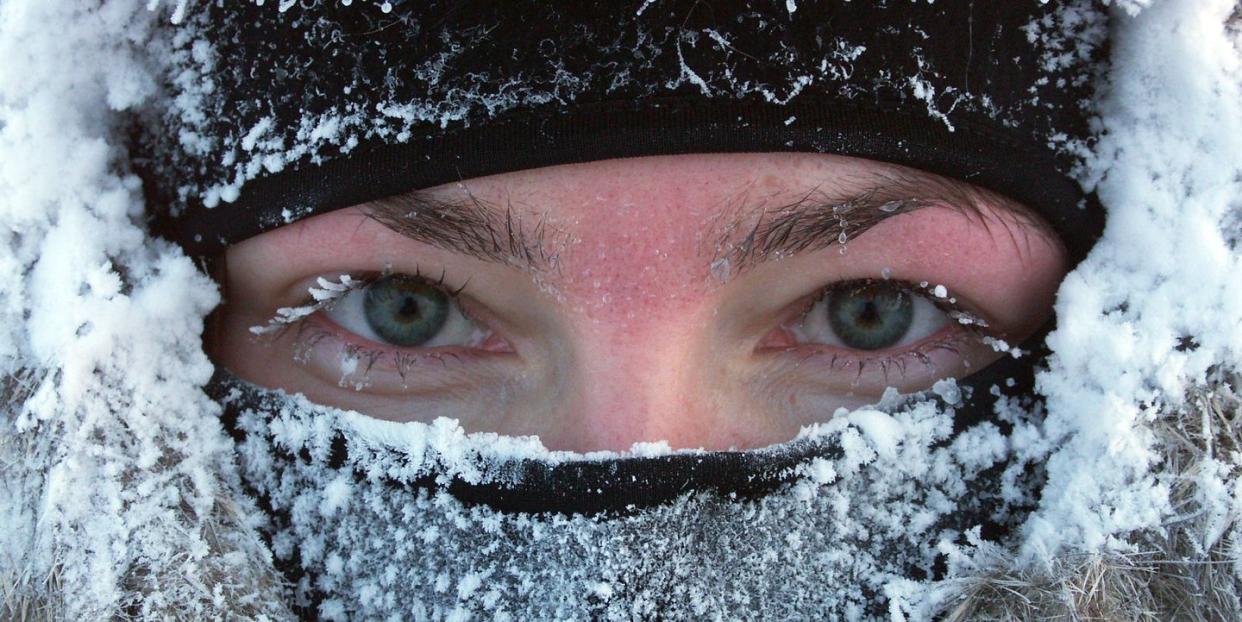Dermatologists Say Your Painful Winter Sunburn May Actually Be Windburn

In winter we experience the joy of holiday eating, spending time with loved ones, and ringing in a new year. But the colder months can have their downsides as well—from seasonal depression to extremely dry skin to an itchy scalp.
Another big one that you may have never even heard of but have probably experienced? Windburn—you know, that moment when your face turns bright red, dry, and flaky after you’ve spent time outside in the cold and snow. In fact, it feels a whole lot like a sunburn on your face in the middle of December.
But why exactly does windburn happen and is it really as bad as dealing with a nasty sunburn? We talked to board-certified dermatologists to get the scoop on this dry skin condition, including how to treat it, and more importantly, prevent it from ruining your next winter excursion.
What is windburn, exactly?
Windburn happens when low temperature, lack of humidity, and wind weakens or damages the top layer of your skin, explains David Lortscher, M.D., board-certified dermatologist and founder of Curology. This impairs your skin’s ability to protect your face, leading to red, dry, and scaly skin. It may also itch, burn, feel sensitive, or start to peel.
“The blood vessels in the outer layer of the skin also tend to dilate (attributing to the redness),” says Michael Kassardjian, D.O., board-certified dermatologist at Coast Dermatology in California and fellow of the American Academy of Dermatology. “Most cases will improve over a few days, but more severe cases can take longer to resolve.”
Spending time outdoors during the winter easily ups your risk of the condition. “Skiing is probably one of the most common activities that can cause windburn, but winter runs, snowboarding, long distance bicycling, motorcycling, boating, or other outdoor recreational activities can also lead to this reaction,” says Dr. Kassardjian.

What’s the difference between sunburn and windburn?
Windburn and sunburn may feel oddly similar, but it’s important to understand how they differ.
“Windburn tends to be more of an irritant reaction, where the wind strips the skin of its protective barrier and reduces its ability to strengthen and moisturize the skin, leading to dryness, inflammation, and redness,” says Dr. Kassardjian. “Sunburn is caused by UV rays directly affecting skin cells, damaging them, and leading to discoloration, premature aging, as well as increasing risks of skin cancer.”
The thing is, windburn and sunburn can occur at the same time, so it can be difficult to determine which one you are dealing with.
“Many times a person who thinks they have windburn is actually sunburned, but windburn and sunburn often coexist,” says Dr. Lortscher. “While the consequences of sunburn are more severe and long-term, I recommend taking preventative measures to avoid both altogether.”
How to get rid of windburn
To minimize recovery time, use these tips from Dr. Lortscher and Dr. Kassardjian to speed up your skin’s healing process.
Moisturize, moisturize, moisturize.
To find some relief, using a moisturizer that soothes dry skin is key. “Look for products with ceramides, which are naturally occurring lipids (fats) in the skin,” says Dr. Lortscher. Moisturizers containing ceramides are especially great for those with sensitive, easily irritated skin.
If you’re super dry and want to try a thicker cream, look for one that contains petrolatum (or petroleum jelly), which forms a protective barrier. Hyaluronic acid and glycerin are also great ingredients to scan for, since they are humectants that help your skin draw in water, says Dr. Lortscher.
Other ingredients that can be soothing include aloe vera, soy, and oatmeal, adds Dr. Kassardjian. The following products contain several of the recommended ingredients:
Slather on the sunscreen.
“Windburn can lead to a reduction in the natural sun-protective ability of your skin, leading to more susceptibility of UV rays penetration and damage,” says Dr. Kassardjian.
Translation: Your skin is already damaged, so it’s going to have a rough time shielding you from harmful UV rays. Make sure you apply a face sunscreen before you head outdoors.
Avoid harsh or scented skincare products.
Products that contain alcohol, exfoliating properties, or lots of fragrance will only delay the healing process and exacerbate the symptoms you are experiencing, says Dr. Kassardjian. Gentle, fragrance-free skincare is your best bet.
Don’t pick at your skin.
“If the skin starts to peel, avoid picking or peeling it yourself and continue to moisturize to avoid any infection, scarring, and hyperpigmentation,” says Dr. Kassardjian. “Additionally, if you are susceptible to cold sores, make sure you see your doctor if you have windburn so you don’t have any major flares.”
Apply a hydrocortisone cream.
Hydrocortisone will help minimize redness, itchiness, and irritation by minimizing your dilated blood vessels. Use a 1% over-the-counter hydrocortisone cream on the windburned areas for at least a couple of days, suggests Dr. Kassardjian.
Don’t over do it. If you don’t feel that it’s getting any better after a couple of days of using an OTC cream, see your dermatologist, who can prescribe an oral anti-inflammatory medication to alleviate the symptoms of windburn. (Docs typically recommend avoiding hydrocortisone cream for longer periods of time as it can lead to skin thinning.)
How to prevent windburn
The best way to prevent windburn from occurring is to cut back on things that dry out your skin during the winter months, so it’s super strong when faced with the elements.
Cut back on strong skincare
“This includes over-the-counter products containing retinol and prescription topicals containing retinoids (such as tretinoin), and treatments such as microdermabrasion or chemical peels for at least several days before (sun and wind) exposure,” says Dr. Lortscher.
Apply moisturizer before you head outside.
Moisturizer isn’t just a treatment for dry skin—using one regularly can help prevent it, too. Be sure to apply a hydrating moisturizer that contains a humectant like hyaluronic acid or glycerin or an emollient like petrolatum, shea butter, or squalane if you are going to spend a lot of time outdoors.
Invest in a humidifier.
Running a humidifier in your home can help mitigate your skin’s moisture loss while you’re indoors, says Dr. Lortscher.
Cool it during your shower.
Finally, make sure your showers aren’t scorching hot, he adds. Opting for cooler ones with a gentle soap won’t dry your skin out or strip it of its natural protective oils, which will make all the difference during dry skin season.
Support from readers like you helps us do our best work. Go here to subscribe to Prevention and get 12 FREE gifts. And sign up for our FREE newsletter here for daily health, nutrition, and fitness advice.
You Might Also Like

